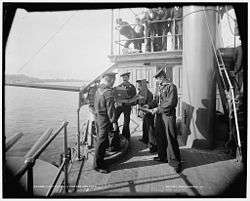Driggs-Schroeder

Driggs-Schroeder was the name of several naval guns designed by US Navy officers William H. Driggs and Seaton Schroeder for the United States Navy in the late 1880s, fitted on ships built in the 1890s. Driggs later founded the Driggs-Seabury Ordnance Company in 1897, in partnership with Louis Labodie "L. L." Driggs and Samuel Seabury, a retired US Navy officer.
Driggs-Schroeder weapons included 1-pounder, 3-pounder (Navy Marks 2 and 3),[1] and 6-pounder (Navy Marks 6 and 8)[2] naval guns.[3] All were rapid-firing, what today would be called "single shot", with brass cased ammunition. They were among numerous models of these guns equipped on US Navy ships of the 1890s. Other manufacturers' designs included fully automatic 1-pounder and 3-pounder guns, but not Driggs-Schroeder. Most Driggs-Schroeder weapons were manufactured by the American Ordnance Company, with some manufactured by Driggs Ordnance Company.[4][5][6][7]
_(14572653078).jpg)
.jpg)
Some of the ships equipped with Driggs-Schroeder guns included USS Texas (1892), USS Maine (ACR-1), USS Olympia (C-6), USS New York (ACR-2), and USS Brooklyn (ACR-3). Olympia is preserved with her Driggs-Schroeder 6-pounders intact at the Independence Seaport Museum in Philadelphia, Pennsylvania.
Sources indicate that Driggs-Schroeder designed a 3.2-inch field gun for the US Army, perhaps the same gun later prototyped by Driggs-Seabury; neither was adopted by the US Army.[8][9] An Army 4-inch/40 caliber Driggs-Schroeder rapid-fire gun also existed, probably the same as one of several Navy guns of this type. Only four were emplaced by the Army in coast defense mountings; two at Fort Washington, Maryland 1899-1921 and two at Fort Warren, Massachusetts 1899-1925.[10][11][12] Driggs-Schroeder designed 6-pounders designated Marks II and III for the Army; they possibly corresponded to the Navy Marks 6 and 8.[13] Some of these were deployed in experimental quantities in coast defenses on "parapet mounts", wheeled carriages with fittings that allowed them to be secured to pintle mounts. A dozen were deployed at Fort Ruger in Hawaii as part of the Land Defense Project of 1915.[14]
References
- ↑ Campbell, p. 147
- ↑ Campbell, p. 147
- ↑ Lohrer, George L. Ordnance Supply Manual, U. S. Ordnance Dept., Washington: Government Printing Office 1904, p. 282
- ↑ Executive Documents of the House of Representatives, 1889-90, Washington: Government Printing Office, pp. 440-441
- ↑ DiGiulian, Tony US 1-pounder guns Mks 1-15
- ↑ DiGiulian, Tony US 3-pounder guns Mks 1-12
- ↑ DiGiulian, Tony US 6-pounder guns Mks 1-13
- ↑ Blueprint for a Driggs-Schroeder 3.2-inch gun from Winchester Repeating Arms Company, at the Buffalo Bill Center of the West
- ↑ Scientific American Vol. 79, Issue 6, article on the 3.2-inch Driggs-Seabury field gun
- ↑ Berhow, pp. 84-85
- ↑ DiGiulian, Tony US 4"/40 guns Mks 1-6
- ↑ Lohrer, George L. Ordnance Supply Manual, U. S. Ordnance Dept., Washington: Government Printing Office 1904, pp. 259-262
- ↑ Lohrer, George L. Ordnance Supply Manual, U. S. Ordnance Dept., Washington: Government Printing Office 1904, pp. 282-295
- ↑ Berhow, pp. 188-189
- Berhow, Mark A., Ed. (2004). American Seacoast Defenses, A Reference Guide, Second Edition. CDSG Press. ISBN 0-9748167-0-1.
- Campbell, John (1985). Naval Weapons of World War Two. Annapolis: Naval Institute Press. ISBN 0-87021-459-4.
- Munsey's Magazine Volume XXVI, October 1901 to March 1902, p. 880. Article paragraph covered the Driggs-Schroeder 6-pounders carried on the USS Olympia, USS Brooklyn, and USS New York.
External links
- William H. Driggs entry at arlingtoncemetery.net
- American Ordnance Company, The Driggs-Schroeder System of Rapid-fire guns, ca. 1900